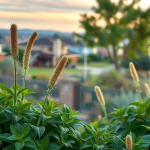
San Diego Winter Climate: What It Means for Your Garden
October 28, 2025Did you know? Over 60% of San Diego’s landscape water use happens during the dry months. But with smart landscape design for dry seasons, you could cut that water use—and your bill—in half! Discover how a few wise, drought-savvy changes will help your yard survive and thrive, no matter how little rain falls this winter.
“Over 60% of San Diego’s landscape water use occurs during dry months. Smart landscape design for dry seasons can cut that in half, saving water and money.” — San Diego County Water Authority
Startling Trends: Why Landscape Design for Dry Seasons is Essential in San Diego
San Diego’s climate is increasingly defined by dry, arid conditions and seasonal water shortages. As citywide water bills climb and watering restrictions tighten, property owners must rethink their landscaping approach—or risk a brown, lifeless yard and higher expenses. Embracing landscape design for dry seasons isn’t just a way to save money; it’s essential for surviving intense San Diego winters that now bring weeks—if not months—without rain.
The key to success? Adopting resilient, drought-tolerant landscaping strategies that reduce water run, improve curb appeal, and add long-term value. Innovations in wise landscape design use native plants, efficient irrigation, and clever hardscape elements to create beautiful, sustainable outdoor spaces. With climate models predicting drier, hotter winters ahead, transforming your front yard or garden bed for reduced water usage will help future-proof your property. You’ll also be doing your part to conserve resources during California’s critical drought years.
What You’ll Learn About Landscape Design for Dry Seasons
- How to assess your property’s needs for dry season landscape design
- Best drought-tolerant landscaping strategies for front yards and more
- Top inexpensive drought-resistant landscaping options
- Wise landscape design principles for lasting results
- FAQs and expert tips for thriving in a dry San Diego winter
Understanding Landscape Design for Dry Seasons
Defining Landscape Design for Dry Seasons
Landscape design for dry seasons focuses on creating vibrant, functional landscapes that use minimal supplemental water, especially during San Diego’s drought-prone months. These designs prioritize resistant plants and efficient layouts, using elements like mulched garden beds, strategic hardscape, and groupings of drought-tolerant varieties. Gardeners and homeowners create microclimates, reduce water evaporation, and maximize shade to foster lush growth even in the midst of a dry climate.
Effective dry season landscaping blends science and artistry: it’s about reading local conditions, choosing the right mix of native plants and Mediterranean species, and planning for year-round beauty. It also means utilizing ground cover and hardscape elements to curb water runoff, and leveraging modern irrigation for water efficiency. The goal is a landscape that’s as attractive in January as it is in July—while remaining sustainable and cost-effective.
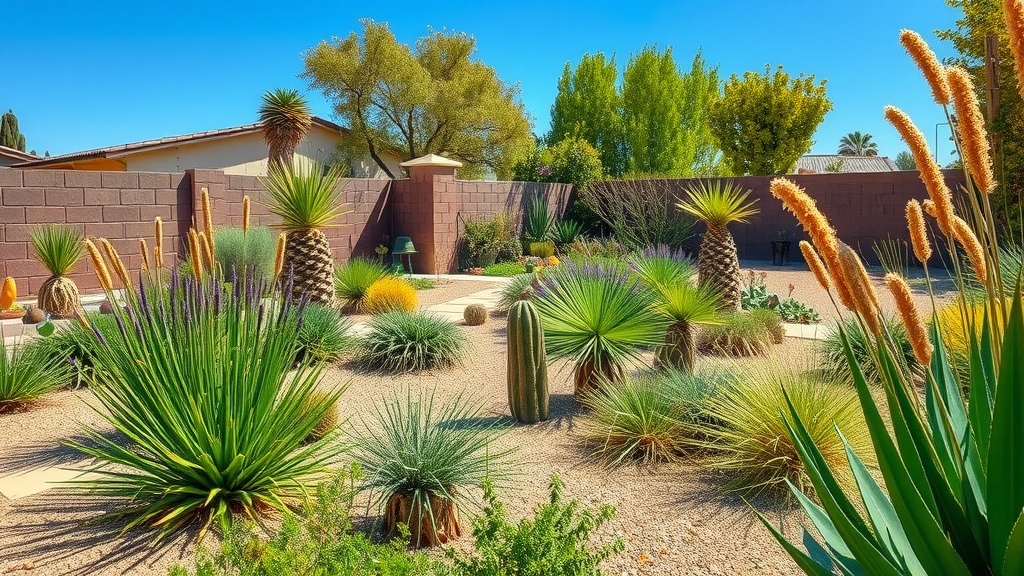
Assessing Your Local Growing Conditions and Dry Climate
The first step in any successful landscape design for dry seasons is assessing your unique site. San Diego’s neighborhoods experience microclimates, meaning your yard might have different growing conditions compared to homes just a few blocks away. Consider your soil’s texture and drainage, sun and shade patterns, and wind exposure. Testing your soil for drainage and nutrients lets you select the best drought-resistant landscaping options—and helps you amend garden beds for optimal plant health.
Evaluate how much sun each part of your property receives, especially during the peak of the dry season. Windy, south-facing slopes may lose moisture quickly, requiring extra organic mulch or shade-tolerant ground cover. Areas prone to water runoff, like driveways or patios, can be transformed into rain gardens to capture and utilize what little rainfall arrives. By tailoring your landscape plan to your microclimate, you’ll build a truly resilient landscape that weathers San Diego’s driest winters with ease.
“The first step in resilient landscape design for dry seasons is knowing your site’s soil, sun, and wind.”
Key Principles of Drought-Tolerant Landscaping
Incorporating Native Plants in Landscape Design for Dry Seasons
Native plants are the cornerstone of any drought-tolerant landscaping plan. San Diego’s indigenous flora, like California lilac (Ceanothus) and manzanita, have evolved to survive harsh, dry winters with minimal water. By favoring native plants, you create garden beds that thrive naturally in our dry climate while drastically lowering your water bill. These species resist local pests, require less fertilizer, and form important habitats for pollinators, ensuring your landscape stays vibrant and ecological all season long.
But don’t stop there—mix in Mediterranean plants such as lavender, rosemary, and sage to add variety and fragrance, and you’ll have a garden that performs like a champion during every drought. These hardy options are also more resistant to unpredictable temperature swings and wind. A diverse planting plan mimics nature, results in a multi-layered, tolerant garden that’s both practical and visually arresting.
Choosing the Right Ground Cover and Mulches
Choosing the correct ground cover and mulches is vital in landscape design for dry seasons. Low-water ground covers such as creeping thyme, ice plant, or dymondia not only replace thirsty lawns but help retain moisture in your soil. These plants form dense mats that suppress weeds, cool the earth, and dramatically reduce water evaporation, all while lending a lush, low-maintenance look to your front yard or garden beds.
Mulching with organic mulch (like bark chips or shredded leaves) further boosts drought resistance by slowing down water runoff and improving soil health. Organic mulches break down over time, releasing nutrients and encouraging beneficial soil life, making them ideal for sustainable, wise landscape design. In especially arid climates, consider layering two or three inches of mulch for maximum impact. This simple step keeps your landscaping investments healthy through the toughest months—and costs a fraction of regular watering.
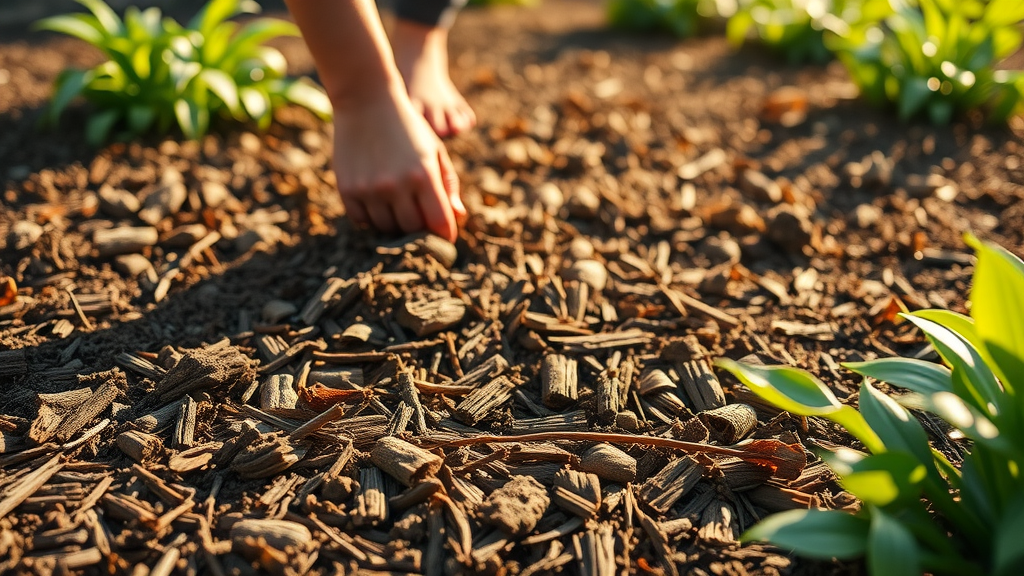
Hardscape vs. Softscape: Balancing Elements for Dry Conditions
Smart landscape design for dry seasons is about achieving the right balance between hardscape (non-plant elements like gravel paths, rocks, and patios) and softscape (living elements such as plants, lawns, and ground cover). Hardscaping reduces areas that need water and provides structure, walkways, and seating that remain attractive and functional in any weather. Gravel paths, decomposed granite, and stone borders can all be used to manage water runoff, direct rain toward plant beds, or create stunning rock garden features.
Meanwhile, softscape choices focus on plants adapted to arid climates, emphasizing layers of ornamental grasses, succulents, and resistant shrubs. A well-thought-out plan means your tolerant landscape will not only excel during dry seasons but also avoid monotony. Remember: less lawn = less water + more time to enjoy your beautiful, low-maintenance yard!
Tolerant Landscaping Innovations: Rain Gardens, Rock Gardens, and More
Building a Rain Garden for a Dry Climate
Rain gardens aren’t just for wet climates—they’re a vital tool in landscape design for dry seasons. In San Diego’s dry spells, the occasional rain can lead to brief, intense water run that often becomes runoff. By grading a shallow basin in your garden, you can direct this precious resource to plants that benefit most. Fill your rain garden with deep-rooted, drought-tolerant plants such as rushes, sedges, and wildflowers that can handle both dry roots and temporary puddles.
This kind of garden bed increases infiltration, minimizes water runoff, and supports your landscape’s overall resilience. Many homeowners pair rain gardens with strategic downspout placement and rock beds to further channel water. Even in arid climates, these features turn rare rainfall into an asset, helping your yard thrive while reducing pressure on local stormwater systems.
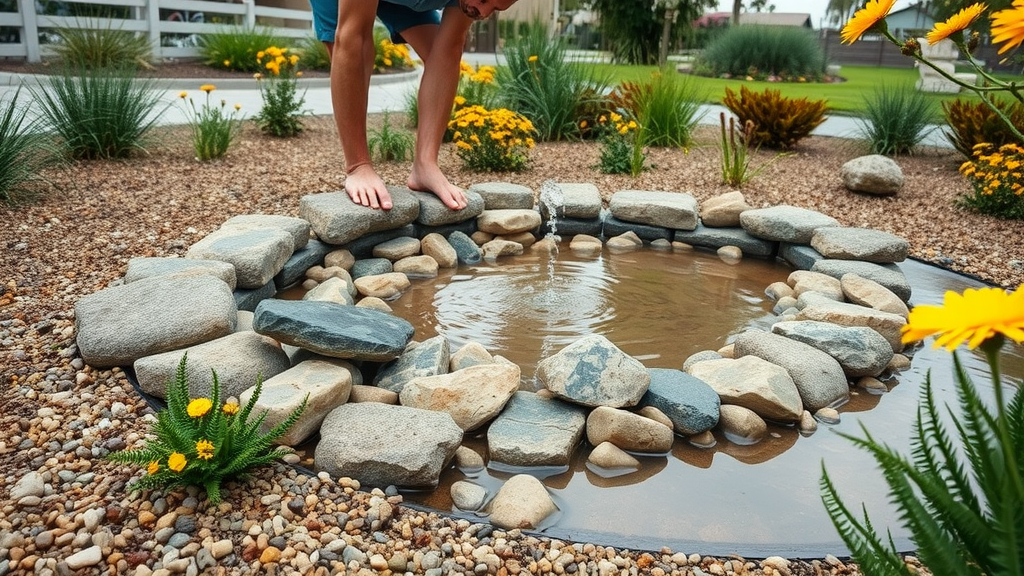
Designing a Rock Garden and Other Tolerant Landscape Features
Rock gardens offer dramatic, cost-effective interest in a tolerant landscape. By blending boulders, gravel, and occasional resilient plants like succulents or ornamental grasses, you create a scene that doesn’t just look good—it stands up to drought year after year. Well-placed rocks help stabilize slopes and reduce water evaporation from the ground, while adding long-term structure to your landscape design.
Beyond rock gardens, try adding decomposed granite patios, dry creek beds, or raised planter beds to further diversify your landscape’s look and function. These elements require minimal water and are easy to maintain, making them perfect for busy homeowners in San Diego. The result? A thoughtful, layered design that resists harsh dry seasons and elevates your property’s curb appeal.
Maximizing the Tolerant Garden’s Visual Appeal
You don’t have to choose between water savings and beauty. Today’s tolerant garden ideas prove drought-resistant landscaping can be lush, colorful, and inviting. Use a tapestry of textures: pair soft blue fescue grass with bold agave, or bright yarrow with trailing ice plant and spiky rosemary. Play with elevation, incorporating mounded beds, retaining walls, and sunken areas for interest and improved drainage.
Consider seasonal color palettes—a dry season landscape doesn’t need to be dull. Plan for bursts of purple, gold, and silver foliage throughout winter and spring. Hardy ornamental grass varieties add year-round motion and contrast, while decomposed granite or river stones highlight vibrant planting areas. These practical, creative touches allow your landscape to stand out while responding to every dry climate challenge.
Front Yard Transformations: Inexpensive Drought and Resistant Landscaping Ideas
- Replacing turf with water-wise landscape design
- Case study: A before/after dry season front yard renovation
- Low-cost plant selections for drought resilience
- DIY irrigation tricks for landscape design for dry seasons
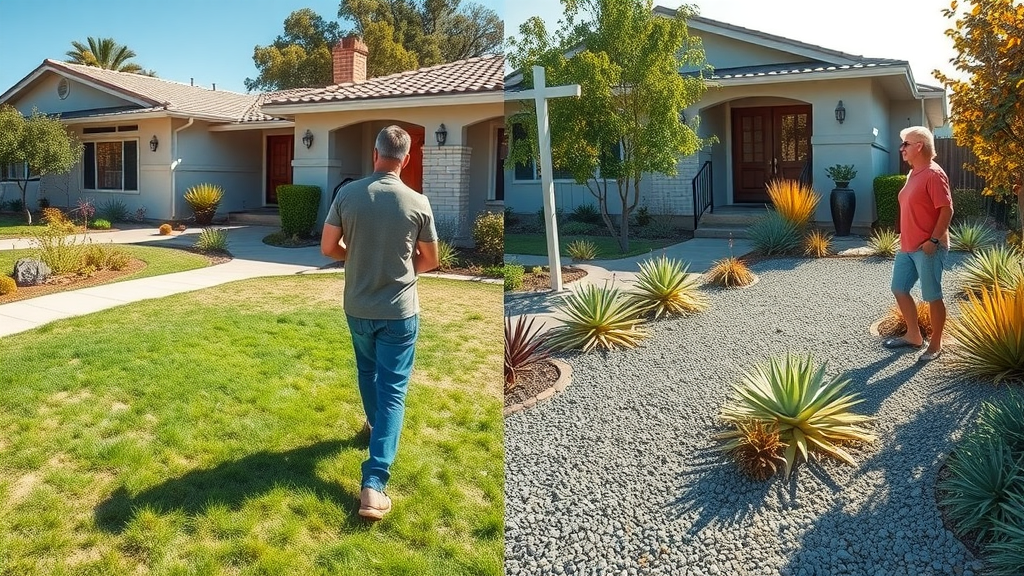
Replacing a traditional front yard lawn with drought-tolerant alternatives is the fastest way to slash your water bill while keeping your outdoor space functional and inviting. Inexpensive options include low-water shrubs, mass plantings of succulents, and durable ground covers like creeping thyme or dymondia. These require less water yet offer rich, green color and interesting textures throughout the year.
A real-life case study: One San Diego homeowner replaced patchy lawn with crushed gravel walkways, a bold rock garden, and beds of lavender and sage. The result? Year-round curb appeal, vastly reduced water usage, and almost zero maintenance. Even more, by retrofitting their old sprinkler system with efficient drip irrigation and scheduling watering at dawn, they noticed significant savings on their water bill. These low-cost upgrades can be DIY or professionally installed and quickly pay for themselves in a single San Diego dry season.
Wise Landscape Design: Planning, Maintenance, and Longevity
Seasonal Maintenance Tasks for Landscape Design for Dry Seasons
Ongoing success in landscape design for dry seasons hinges on regular, targeted maintenance. Each winter, audit your irrigation system for leaks, stuck valves, and over-spraying. Clean out rain gutters and downspouts to ensure water run is directed toward your landscape—not wasted on walkways or pavement. Refresh organic mulch to retain moisture and suppress weeds in garden beds and around ground covers.
Cut back resilient perennials and ornamental grasses in early spring to encourage healthy, dense growth. Check for compacted or depleted soil, and top dress beds as needed with compost or mulch. Regular pruning and removal of sickly plants keeps your tolerant garden robust all season long, primed to resist pests and disease during harsh, dry periods.
Long-Term ROI: Water Savings and Curb Appeal
Investing in wise landscape design means more than just short-term water savings: Over time, your resilient yard delivers continuous value in curb appeal, lower long-term costs, and increased property value. Homebuyers increasingly seek resistant landscaping that looks stunning while requiring fewer resources. In neighborhoods where water restrictions hit hard, your tolerant landscape becomes a standout selling point.
Data shows San Diego properties with well-executed dry climate landscape design enjoy up to 20% higher curb appeal compared to traditional lawns. Consistently lower water bills and annual maintenance mean your investment quickly pays for itself—and remains future-proof as California’s droughts become more frequent.
“A wise landscape pays off year after year, especially through dry winters.”
Comparing Landscape Design for Dry Seasons: Tables and Checklists
| Plant Type | Proven Drought Resilience | Average Water Use | Cost per Plant (Approx.) |
|---|---|---|---|
| California Native (e.g., Ceanothus) | Excellent | Low | $8–$15 |
| Succulents (e.g., Agave, Echeveria) | Excellent | Minimum | $3–$10 |
| Mediterranean Herbs (e.g., Lavender) | Very Good | Low | $4–$12 |
| Ornamental Grasses (e.g., Blue Fescue) | Good | Low | $6–$12 |
| Ground Cover (e.g., Dymondia) | Good | Low | $1.50–$3/plug |
| 1. Evaluate local soil, sunlight, and wind exposure (Growing Conditions). |
| 2. Remove or phase out high-water-use turf grass. |
| 3. Select drought-tolerant native and Mediterranean plants. |
| 4. Install efficient drip or smart irrigation systems. |
| 5. Add 2-3 inches of organic mulch in garden beds and around new plantings. |
| 6. Incorporate hardscape features such as gravel paths, rock beds, or patios. |
| 7. Group plants by water needs to allow for efficient watering (Hydrozoning). |
| 8. Monitor and adjust irrigation based on the season or rainfall. |
People Also Ask: Common Questions About Landscape Design for Dry Seasons
What are the best plants for landscape design for dry seasons in San Diego?
“Native and Mediterranean species thrive best in San Diego’s dry seasons.”
The top performer plants include California natives like manzanita, buckwheat, and toyon, as well as Mediterranean varieties such as lavender, rosemary, and olive. For ground covers, try creeping thyme or dymondia. These plants are bred by nature for low-rainfall environments, require less water, and provide robust color and habitat for local wildlife. They’re the building blocks of tolerant landscaping and resilient, wise landscape design all year.
How do I make my landscape design more drought-resistant?
The transition to a resistant landscaping style begins with phasing out traditional lawns in favor of low-water-use plant beds. Focus on grouping plants with similar water needs and installing a drip irrigation system to reduce water waste. Use mulch thickly to retain moisture and inhibit weeds, and choose hardscape accents like decomposed granite or river pebbles to limit areas that require supplemental water. Regular audits of your irrigation and attention to soil health will keep your landscape design performing in every dry season.
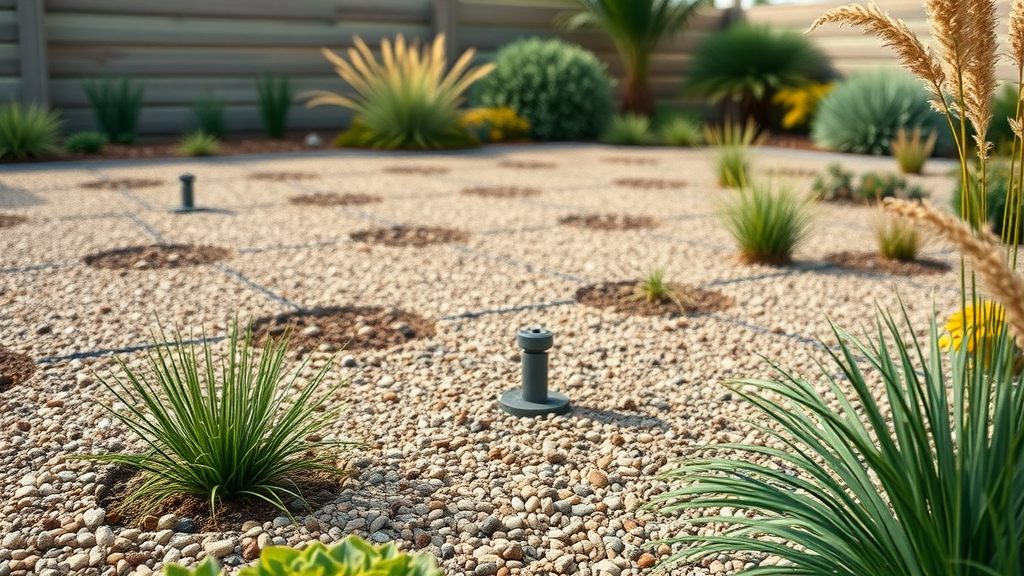
Is installing a rain garden effective for San Diego winters?
Absolutely. While rain is infrequent in San Diego winters, when it does come, it’s often rapid and leads to water runoff. Creating a rain garden ensures your landscape captures, slows, and retains this water, diverting it from storm drains and putting it to good use in your soil and plant root zones. You’ll reduce water run, improve groundwater recharge, and support the survival of drought-tolerant plants even during unpredictable weather cycles.
What is the cost of inexpensive drought-tolerant landscaping for the front yard?
On average, you can transform a standard front yard using drought-tolerant landscaping for $1,500–$4,000, depending on scope and plant size. DIY approaches lower costs significantly, especially for ground covers, succulents, and ornamental grasses. Factor in savings on your water bill over time—most homeowners report full ROI within two to four years thanks to reduced water usage and maintenance needs.
How do rock gardens and ground cover contribute to dry climate landscaping?
Rock gardens provide structure, visual interest, and areas where water run is minimized, allowing you to focus precious irrigation on plantings that need it. Drought-hardy ground cover choices like creeping thyme or dymondia shade the soil, suppress weeds, and cut water evaporation dramatically. These features combine to create wise landscape design ideally suited for resisting heat, drought, and water restrictions—all while keeping your yard beautiful.
Timelapse shows brown lawns transformed into lush, low-water tolerant landscaping with gravel paths and vibrant plantings—perfect for every dry San Diego winter.
Expert Tips & Key Takeaways for Landscape Design for Dry Seasons
- Mix native and Mediterranean plants for best drought performance
- Mulch generously to retain soil moisture
- Plan your irrigation for efficiency — drip is best
- Audit your landscape yearly for dry season preparation
- Use hardscape elements for impact and low water use
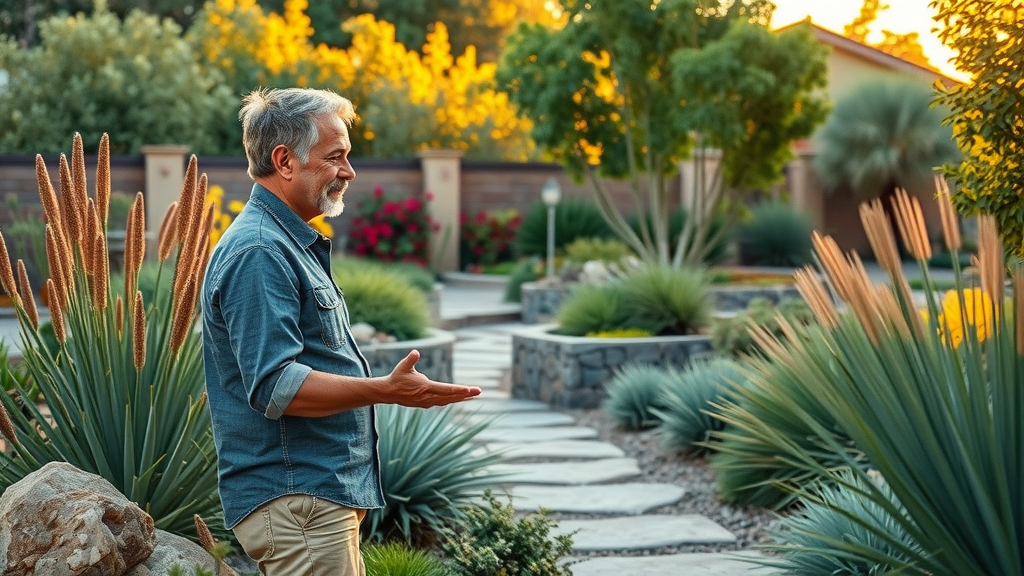
FAQs: Landscape Design for Dry Seasons
How often should a drought-tolerant landscape be watered in winter?
In San Diego’s dry winters, most resistant landscaping only needs a deep watering every 2–4 weeks, depending on rainfall and plant establishment. Newly planted areas may require slightly more frequent watering until roots are well established. Always monitor soil moisture and adjust your irrigation schedule to avoid water waste and encourage deep root growth.
What is the most cost-effective way to renovate a front yard for dry seasons?
The most cost-effective approach begins with removing lawn and converting it to plant beds filled with drought-resistant selections like succulents and native plants. Installing mulch and drip irrigation will minimize maintenance and maximize efficiency. Consider doing some steps yourself—planting or mulching—to save labor costs, and source plants during seasonal sales for even greater savings.
Are professional landscape designers worth hiring for wise landscape design in a dry climate?
Yes—hiring a professional for wise landscape design pays dividends in plant selection, efficient layouts, and avoiding costly mistakes. They have advanced knowledge of San Diego’s specific growing conditions, access to quality materials, and experience installing hardscape and irrigation for maximum resilience. A pro can also help you access rebates or incentives for water-wise upgrades, saving you money right from the start.
Conclusion: Sustainable Benefits of Landscape Design for Dry Seasons in San Diego
“Investing in landscape design for dry seasons ensures your property weathers every San Diego winter beautifully while conserving water.”
Get Expert Help: Contact a Landscape Contractor for Your Dry Season Design
- Ready for a resilient, beautiful yard that beats drought? Work with a certified expert.
- Visit Breceda Landscape to connect with a skilled landscape contractor: https://brecedalandscape.com
Sources
- https://www.sdcwa.org – San Diego County Water Authority
- https://www.cnps.org/gardening – California Native Plant Society
- https://waterwisegardens.org – Water Wise Gardens
- https://www.epa.gov/watersense/landscaping-tips – EPA WaterSense Landscaping Tips
To enhance your understanding of drought-resistant landscaping, consider exploring the following resources:
-
“12 Stunning Drought-Resistant Landscaping Designs Today”: This article showcases innovative designs that combine ecological sustainability with aesthetic appeal, featuring native plants and xeriscaping techniques. (archeworks.org)
-
“12 Drought-Tolerant Landscaping Ideas”: This piece offers practical ideas for creating low-maintenance, water-efficient gardens, including the use of native plants and rock gardens. (lawnstarter.com)
These resources provide valuable insights into creating beautiful, sustainable landscapes that thrive in dry conditions.

